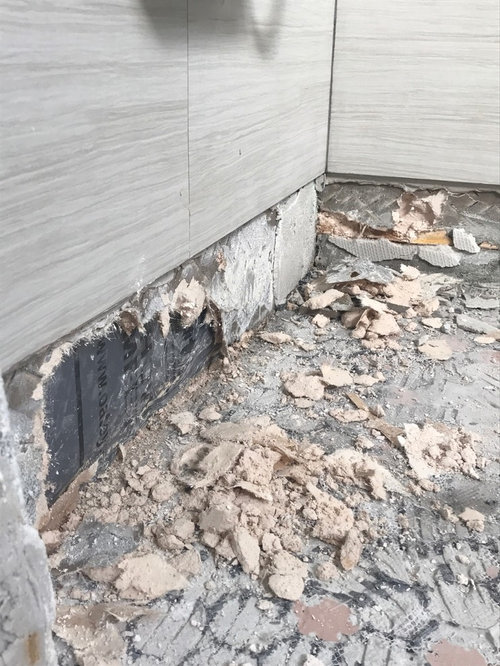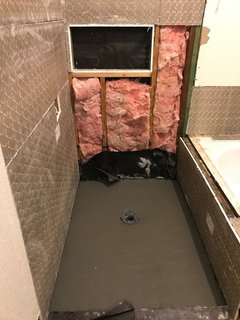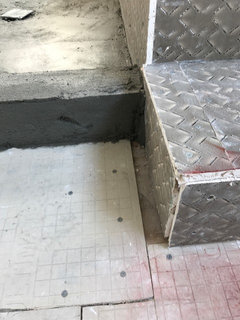Is tile backer board supposed to get wet? Help please
So I was in the process of replacing my shower tile floor when the worker found that the backer board was wet. He poked at it and took off a piece of tile from the bottom row and pretty much pulled the board off and it crumbled and felt very moist. This is certainteed diamond board as the back with thinset and porcelain tiles. Shower is 1 year old.
I told my contractor who told me that water is going to get behind the tiles and that it's not a problem. That seems contrary to all I read about how no water should be behind the tile walls. There's been a lot of disagreements on how things are done. Can anyone help and tell me if the diamondboard backer getting wet and pretty much I'm able to pull it off with gentle force. I've attached a photo.
Thank you.

Comments (20)
Mint tile Minneapolis
5 years agolast modified: 5 years agoDiamondback rock and denshield should be outlawed along with that cheap liner approach. You have the perfect storm there.. Suprised it lasted a year
Likely they buried or set the raw gypsum edge in the mud and its been wicking upwards ever since.
Chris
Original Author5 years agoHey I was afraid of that. At this point the same person tore up the floor and some of the wall as seen, they are willing to redo it for free (I am considering hiring a diff company), but if I go ahead and have them do it what should I do? Is there anyway to salvage it by replacing the diamondboard on the bottom with something else?
Do I have to rip it all out and re do it or can I somehow save it by just replacing the bottom edge if there's no moisture any higher up?otterkill
5 years agoCurious why you were replacing the shower floor? Was this also done by the previous contractor last year?
Joe P
5 years agoIf that's what the bottom looks like, there's no guarantee it's better higher up. And the materials they used are not appropriate for the job. Definitely needs a gut. Your contractor did it wrong and you should try to recoup some money but in practice that often means you would give them a chance to redo it. However, this guy sounds pretty incompetent.
MongoCT
5 years agolast modified: 5 years agoThis is the problem with gypsum-core boards used in showers. Although they may have "waterproof coatings" on the face of the boards, the panel edges and any fastener or plumbing holes are the weak points. When moisture gets in to the gypsum core, the board turns to mush. It's the nature of the product, as the core has no structural integrity when wet.
IT'S DESIGNED THAT WAY.
It seems that the board was not installed in accordance with the manufacturer's installation instructions. The bottom edge of the wall board should not have been buried in the mud bed. You can find the installation instructions online.
As far as repairs being made? I never "repair" part of a flawed installation like yours. The reason being that if this part was done incorrectly, it's likely that there are other problems with the installation as well. If I repaired just the bottom part of your installation, by doing the work I'm essentially assuming responsibility for any future failures with any other part of the installation, even parts that I never touched.
That's the reason that reputable and conscientious installers, when it comes to water damage repair, will often only do a gut repair. The only way I repair someone's shoddy work is by eliminating and erasing their work completely via demolition and a dumpster.
All that written? Sure, someone can "repair" the bottom part of the wall. A proper repair, that's another issue altogether.
Aside: Showers should always be built with the idea that water will get behind the tile. Tile and grout shed water, but water can wick though the grout. For showers with mud beds like yours, the mud bed under the tile and grout usually becomes wet with moisture the first few times it's used.
The membrane in your shower that's underneath the mud bed? The membrane itself should be sloped to the drain, with the membrane being installed on top of a sloped mud bed called the "preslope". On top of the sloped membrane goes another bed of mud which follows the slope of the membrane, your tiles get installed upon that second mud layer. With the membrane itself being sloped, the slope encourages excess moisture in the mud bed to travel down the slope and exit via the weep holes in the drain.
A common shortcut is for installers to place the membrane flat on the subfloor and to place a single sloped bed of mud on top of the flat membrane. Because the membrane is flat, the mud bed can hold significant water, and over time it can turn into a stinky contaminated mess. It's both a construction shortcut and a code violation.
Mint tile Minneapolis
5 years agolast modified: 5 years agoChris
You simply have not given me enough pictorial evidence to comment further , i think you know the answer here.In regards to the poster that said they used the wrong materials?
Unfortunately, diamondback and oatey pvc liners are approved still to this day for a shower build. Its a poor bottom of the barrell approach to materials. But Its the skill and execution of the install thats the bigger issue here alomg with GYPSUM which simply doesnt belong in a wet area.. By using the cheap materials you may save a few hundred bucks in a shower build, but if you dont know how to build a shower you have a perfect storm.
One of the many ways you will know when you have a tile pro in your midst? the experienced skilled ones will refuse to use either of those materials, and will not engage in partial repair attempts to make a quick buck. That comversation for me ends on the first phone call.
Creative Tile Eastern CT
5 years agolast modified: 5 years agoI also see clean Diamond back board with spots of thinset mortar indicating a good probability of spot bonding. A big No No. I would not allow a second attempt. There are to many signs showing even the basics are not being followed. Tundra & Mongo are spot on with the wicking scenario. Sorry for your situation.
Joseph Corlett, LLC
5 years agoIt isn't fair to Certainteed and/or Oatey to blame their product for installer error. You may or may not like their products, but if you follow the manufacturer's instructions, you'll have years of worry and leak free service.
Dragonfly Tile & Stone Works, Inc.
5 years agoWell, not often you'll get Mongo, Tundra, and Creative (3 of the few real tile Pros that comment) on one thread. So I'll make it 4 and simply agree with their comments. It's a sad situation, and it's a re-do. We wouldn't touch a "repair" job either, for all the reasons stated above. Good luck moving forward.
Chris
Original Author5 years agoOk that's what I was afraid of. I should have done the research, that's a very helpful link to finding a tile installer thank you. Just another case of a naive first remodel. The tiles do not appear to be spot bonded I believe the thinset was applied fully to the back, just some parts ripped off completely when the tile pulled off. I'm trying to find a "suitable" quick fix for now, I realize I may have to gut it but this contractor is offering up fix it (whatever that means to him), as you mentioned these materials are approved to be used (not that they should). I did read the installation instructions for the backer and it says to leave a 1/4 inch gap and fill with flexible sealant at the bottom. Is it that horrible to have them do that if it wasn't put in correctly? I do wish I found this forum earlier but hindsight is 20/20. I did attach pics of the install process if that helps but I realize I eventually have to re do this. Thank you all.



cat_ky
5 years agoWhy would you want to do a temporary fix, when you know you will have to redo it. Tear it out, and do it right, and not have to worry about it ever again.
Creative Tile Eastern CT
5 years ago"The tiles do not appear to be spot bonded I believe the thinset was applied fully to the back" If the thinset mortar was applied correctly it would have been keyed into the board with the flat side of a trowel first. You would not be seeing clean board in your photo's. They may not have spotbonded but they certainly did not set the tile correctly to achieve the 95% coverage required for a wet area.
Chris
Original Author5 years agoI was asking mainly due to Joseph's comment that if installed correctly the gypsum backer is ok? I know that it's not the best now and I get that, but if it's going to be "just ok" and save a complete gut job, because currently the shower is just stripped of the floor, I hadn't planned to gut the whole thing because I had no idea. I guess it's a way of getting the best of what I got, since this contractor says they will fix it, but I know he won't redo it entirely because he is stubborn that this way is "correct". Also in the meantime Id have to find a new and competent installer etc.millworkman
5 years agoThe reason is the lower portion being that bad you very well have a moldy mess and progressively heading towards looking like the bottom. A "repair" will not address this. If there is mold and rot at the bottom do you want to expose yourself to the potential for mold in the rest of the shower in lieu of the correct redo?
Dragonfly Tile & Stone Works, Inc.
5 years agolast modified: 5 years agoChris, for the reasons the tile pros here have stated, none of us would recommend a "repair" when it is clear the installation did not meet standards. Your dilemma is actually whether you are comfortable with letting this contractor do whatever he says he will do and it will be "OK". I'm guessing that he says he will do it for free because he was the original installer and the pan failed (so you may have a leak in the ceiling of the room below)? So if you know that you will likely have to replace the shower in the future, I guess you are asking if it's OK to let this guy try a short term "fix" to buy you some time. Only you can answer that as we've told you what some of the obvious problems are already. Have you asked him to guarantee the work for 5 years since he's so sure it will be "OK"? And yes, consider the potential mold issue millworkman mentioned. There is such thing as trying to fix a problem and ending up with a bigger one.
User
5 years agoChris, I'm a carpenter, but I've seen plenty of lousy tile jobs and I've set enough tile in my own home to know you're getting dang good advice from the pros here.
Do yourself a favor. Listen to them.
ChrisOriginal Author